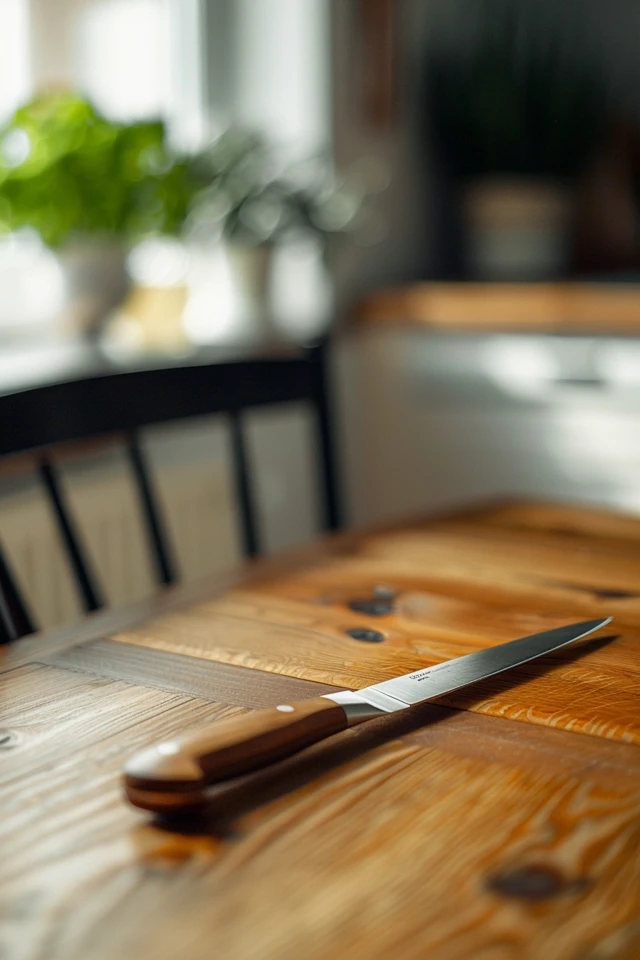When it comes to cleaning a rusty knife blade, the method you use depends on the type of knife and the extent of the rust. Proper knife maintenance is essential to ensure the longevity and functionality of your blades. In this article, I will share some restoration tips and knife maintenance tips to help you remove rust from your knives and restore them to their former glory.
Key Takeaways:
- There are different methods to remove rust from knives based on the type of knife and extent of rust.
- For basic tools like axes or hammers, a bench grinder with a wire wheel can be effective.
- To restore older knives, a gentle approach using steel wool, toothpaste, and a toothbrush is recommended.
- For general-purpose fixed blades, steel wool and regular oiling can prevent rusting.
- Newer folding knives may have warranties or can be disassembled for cleaning.
Using Vinegar to Remove Rust
If you’re looking for an effective and cost-efficient method to remove rust from a knife blade, look no further than white vinegar. Vinegar, with its acidic properties, can work wonders in rust removal.
To begin, gather a tall container that is suitable for submerging the blade. Fill the container with white vinegar and carefully place the rusty knife blade in it. Allow the blade to soak in the vinegar for approximately 5 minutes. This will give the vinegar enough time to break down the rust on the surface of the blade.

After the soaking process is complete, take a sponge or a toothbrush and gently scrub the blade to remove the loosened rust. The acidity of the vinegar will aid in dissolving the rust, making it easier to clean.
Once you have thoroughly scrubbed the blade, rinse it under running water to remove any remaining vinegar residue. It is crucial to ensure that the blade is completely dry to prevent the formation of further rust. Using a clean and dry cloth, wipe the knife blade until it is free of moisture.
Vinegar is a natural rust remover, making it an excellent option for cleaning knives. It is also a cost-effective alternative to purchasing specialized rust removal products. Next time you encounter a rusty knife blade, consider using vinegar for a simple and effective rust removal solution.
Scrubbing with Lemons and Salt
If you’re looking for a natural and effective way to remove rust from your knife blade, try using lemons and salt. This method harnesses the power of citrus and the abrasive qualities of salt to restore your rusty blades to their former glory.
To get started, cut a lemon in half and use one of the halves to rub directly onto the rusty areas of the blade. The acidity of the lemon helps to break down the rust while imparting a refreshing citrus scent. Be sure to cover all the rusty spots, ensuring that the lemon juice comes into direct contact with the rust.
After applying the lemon, take a sponge or a soft toothbrush and gently scrub the blade. This additional scrubbing action helps to loosen the rust even further, making it easier to remove.
“The combination of the lemon’s natural acidity and the salt’s abrasiveness creates a powerful rust-fighting duo.”
Now it’s time to tackle the rust head-on with salt. Take the other lemon half and dip it into a small bowl filled with salt. Use this lemon and salt combination to continue scrubbing the rusty areas of the blade. As you scrub, the salt will dissolve and provide an extra abrasive element to lift away the rust.

Once you’ve thoroughly scrubbed the blade, it’s important to wash away any residue. Use soapy water to gently clean the knife, making sure to remove all traces of lemon juice and salt. Rinse the blade thoroughly and dry it with a soft cloth to prevent any leftover moisture from causing further rusting.
Finally, to protect your newly restored blade from future rusting, apply a thin layer of oil to both sides. This helps to create a barrier that prevents moisture and oxidation from reaching the metal surface. Be sure to use a food-grade oil suitable for knife blades.
By using lemons and salt to remove rust from your knife blade, you’re not only employing a natural and eco-friendly method but also harnessing the power of citrus and abrasiveness to restore your blades. This cost-effective approach can help you maintain the longevity and functionality of your knives while keeping rust at bay.

Conclusion
After exploring different methods for rust removal and knife restoration, it’s clear that cleaning a rusty knife blade requires careful consideration and attention to detail. By understanding the type of knife, the extent of rust, and the desired outcome, you can choose the most suitable method for restoring your knife.
Using vinegar or lemons and salt can be effective natural alternatives for removing rust from knife blades. Vinegar acts as a natural rust remover, while the acidity in lemons helps break down the rust. Scrubbing with a sponge or toothbrush helps to further loosen and remove the rust particles. By following these methods, you can restore your knife blades back to their original condition.
It is crucial to thoroughly clean and dry the knife after rust removal to prevent further corrosion. Applying a protective coating of oil to the blade will help create a barrier against moisture and prevent future rusting. Regular maintenance and oiling of your knives will contribute to their longevity and keep them in optimal condition.
Remember, rust removal and knife restoration require attention to detail and proper care. By implementing these restoration tips, you can extend the lifespan of your knives and enjoy their functionality for years to come.

